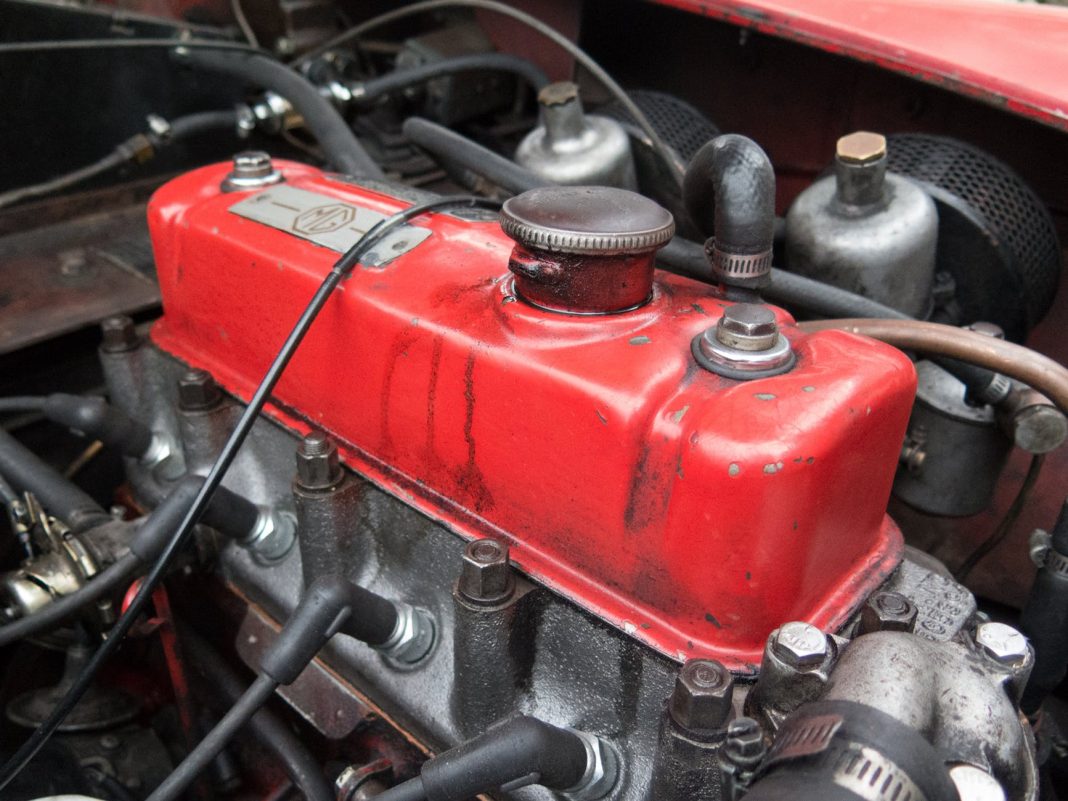 |
|
| Issue #83 • September/October, 2003 |
Those of us living beyond the suburbs own various sizes and types of yard and garden machinery. From the mandatory riding lawnmower for those weekend warriors with one-acre yards up to 4-wheel drive diesel tractors for working farms, everywhere you look there are engine-driven machines to make rural life easier. Many of us now also own RVs, ATVs, log splitters, garden tillers, leaf vacuums, chipper-shredders, portable generators, and garden tractors, and each may use some type of battery that must stay charged.

A small solar module, attached to the roof of this tractor, ensures that the starter will still turn over, even after a long period of idleness.
Larger farms have motorized hay balers, planters, plows, and an endless array of other specialized types of crop machinery. If you are like me, your little stable of power machinery sits weeks or seasons between uses and rarely start when needed due to discharged or dead batteries. The pull cord starter is now a rare exception, not the rule, so you are left with few options. A typical flooded lead acid battery will lose up to one percent of its charge per day while idle. In just over two months, this would mean a drop to almost half the original amp-hour capacity.
The solution for most homeowners would start with a search for that rarely used $10 battery charger and tangled cables buried somewhere in the back of the garage. Since tractor batteries never fail when parked next to a wall outlet, the next task is locating a 100-foot extension cord. After finally figuring out which cable goes to which battery terminal and in which order, the deceased battery is brought slowly back to life. There must be a better way, and new battery charging technologies are providing several good solutions to this age-old problem.
Battery Design 101

Even a small riding mower can benefit from the installation of a solar panel that ensures its battery is always ready.
Before going into more detail on how you can keep all of your idle equipment batteries fully charged, let us briefly review some battery design basics. Battery technology has undergone major changes during the past few years as manufacturers search for higher amp-hour capacities in smaller packages, lower weights, and zero maintenance.
There are many new battery design features that lower weight and increase charge density, but most have been accomplished through very exotic materials and chemicals that are difficult or impossible to recycle, not to mention having a much higher cost. On the other end of the scale, the old technology and fully recyclable flooded lead acid battery has also undergone some major changes. To eliminate periodic water refilling, most flooded-type car, truck, and marine batteries now include gas re-combiner caps that take the venting battery gases and convert them back to a liquid, which then drains back into the battery cells. These special caps are usually permanently attached as the liquid electrolyte is intended to last the life of the battery.
To reduce maintenance even further, battery manufacturers now offer valve regulated lead acid (VRLA) batteries in both gel cell and absorbed glass mat (AGM) designs. Unlike the maintenance-free flooded liquid electrolyte batteries, VRLA batteries are completely sealed and pressurized and can be mounted in any position, including upside down.
The valve regulated gel cell is still technically a lead acid battery, but the acid and water electrolyte have been converted into a jelly or paste, which is injected into all internal spaces around the lead plates just before the battery is permanently sealed. The valve regulated AGM batteries have porous fiberglass pads pressed against each side of the lead plates, which are then soaked with liquid electrolyte prior to battery sealing. These valve regulated sealed batteries do not have any filler caps and do not require any maintenance.

VRLA batteries are completely sealed and pressurized and can be mounted in any position, including upside down.
Although more and more mowers and garden tractors are now being sold with sealed gel or AGM batteries, there are still many conventional flooded lead acid batteries in service due to their much lower replacement costs.
Conventional battery charging
When planning an alternative method of maintaining the charge for your occasional-use motorized equipment batteries, it is very important to identify which battery type you have, since different battery types require different charging voltages. This also means that many older style battery chargers are not suitable for charging many of the newer battery types.
Most published battery charging data tables are based on a standardized ambient temperature of 77° F. Higher or lower battery temperatures will require adjusting the manufacturer’s recommended charging voltages to achieve the same level of charge. As a rough guideline to determine which voltages to use, it is recommended to subtract 0.1 volt from the table values above 85° F ambient. Below 55° F ambient, it is recommended to add 0.4 volt. When charging below 35° F ambient, it is recommended to add 0.7 volt to the table values. Many of today’s newer battery chargers include a temperature sensor that takes care of this adjustment for you.
When referring to the following battery charging comparison table, note how a higher charging voltage is used during the initial bulk charging period than used for final float charging. This provides a shorter overall recharge time, while reducing the chance for overcharging at the end of the charging cycle. Be sure the battery charger you use has the appropriate output voltage for the battery type to be charged; if in doubt, check the manufacturer’s charging information that came with your battery.

Inexpensive solar modules, 5 to 10 watts in size and 1 to 2 square feet in surface area, are adequate for maintaining a charge on an idle battery.
Low-cost battery chargers usually do not have automatic cycle or timer controls, and provide the same charging voltage, regardless of how discharged or over-charged your battery may be. If left connected for an extended period, these inexpensive chargers can easily damage a battery by “boiling” all of the electrolyte out of the battery. If the battery is sealed, this overcharging could actually destroy the battery.
More expensive battery chargers include automatic controls that constantly take sample measurements of the battery’s present voltage through the charging cables, and adjust the charging process accordingly. These newer chargers start the charging process with a high bulk charge voltage and amperage to minimize charging time, then automatically switch to a lower absorption charge rate as the battery reaches a fully-charged state.
Finally, after fully recharging the battery, these more sophisticated chargers switch to a very low float or trickle charge, which is just enough current to offset the normal charge loss for a battery in a standby or idle state. These chargers usually have a battery selector switch or jumper to modify all charging voltage and current setpoints as required by each battery type.
Standby battery charging

For equipment normally kept inside a shed out of the weather, your best charging solution is an electronic battery float type charger such as this 120-volt VAC battery float charger.
We are going to assume the charging systems on your mowers and tractors are providing adequate bulk charging to keep the batteries fully charged while in use, but you need some way to provide a float charge for those long periods when your equipment is not being operated and the batteries are slowly discharging.
This means any battery float-type charger we install to hold a battery at full charge does not need to have a high charging amperage. However, it will need to have battery monitoring technology to prevent over-charging and boiling all of the electrolyte out of the battery. I have found two very reliable products to do this, and both can be installed with minimum wiring skills and tools.
Most solar module manufacturers now offer a small self-regulating version of their larger solar photovoltaic panels. These modules are usually 5 to 10-watts in size which is 1 to 2 square feet in surface area. Some manufacturers make their solar modules using non-glass covered solar cells bonded onto the surface of a metal sheet, as shown in the accompanying photos of actual installations. Several manufacturers offer a module made of an unbreakable plastic laminate solar material mounted in an aluminum frame, which is ideal for more rugged applications.
One manufacturer even offers a flexible solar sheet having an adhesive backing that can be bonded directly onto metal roofing or a metal engine enclosure. All of these self-regulating modules include an internal diode or a reverse flow protection circuit to keep the battery from discharging back through the connected solar module when the sun is not shining. If you choose to use a larger non-regulated solar module, you will need to add a charge controller to regulate the battery charging process. Without a reverse flow protection diode or a charge controller, your solar charging system may discharge more of the battery charge at night than it will make up during a sunny day.
|
Connecting a self-regulating type solar module to any battery is simple. These modules are usually shipped with several feet of pre-wired cable ready for direct battery connection. No fuses, switches, or other electrical equipment are needed due to the very low voltages and currents produced. These modules can be mounted directly to the roof or motor housing of the mobile equipment by screws or bolts. Of course the obvious downside for any solar powered battery charger is the solar module must receive sunlight to work, which is not possible if the equipment is sitting in a garage or not facing the sun.
If you have engine driven equipment that are normally kept inside a shed out of the weather, but you still need to keep the battery charged during weeks or months of non-use, your best charging solution is an electronic battery float type charge. These units are approximately the size of a small box of tea, and can be permanently mounted directly under the hood or engine cover of your motorized equipment. Instead of the usual alligator clamp type battery connecters, these battery wires terminate with large diameter ring terminals held in place by the battery terminal bolts. The 120-volt power cord can be left plugged in continuously, since these chargers will not overcharge or over-heat a battery even if never disconnected.
Since they are only providing a very tiny trickle charge to maintain an already fully charged battery, they use only a minimal amount of electricity. I like to use these on all standby electric generator installations since generator starter batteries are notorious for reaching their fully discharged state just in time for the next power outage.
Regardless of which standby battery charging method you use, the next time you drag that riding mower out of the garage after a long winter, it should start right up. Unless of course the gasoline you accidentally left in the tank has now turned into paint thinner.

[weaver_widget_area id=’articles_about_yago’ class=’text3′]














